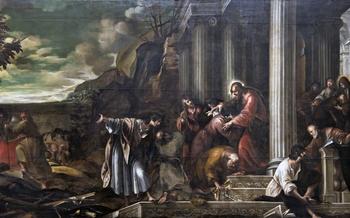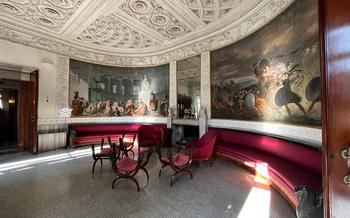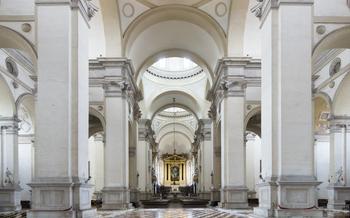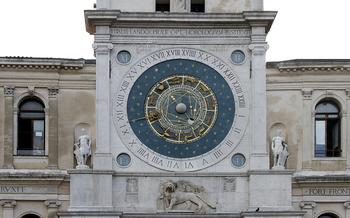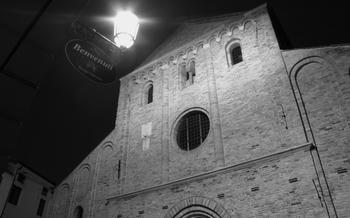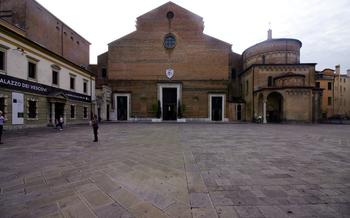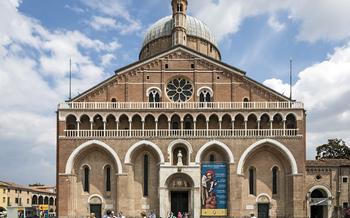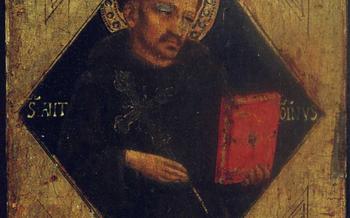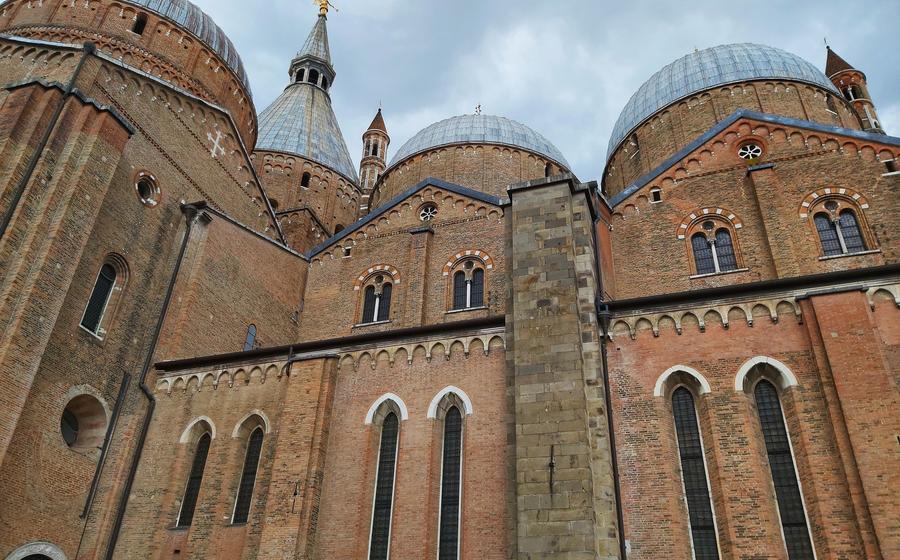
Basilica di Sant'Antonio da Padova
- History and Background
- Exterior Marvels: A Symphony of Stone and Sculptures
- Stepping Inside
- The Saint's Sanctuary: Cappella del Santo
- Exploring the Cloisters
- Artistic Masterpieces
- Museum and Treasury
- Musical Traditions
- Mass and Worship Services
- Festivals and Events
- Accessibility and Visiting Tips:
- Surrounding Attractions
- A Hidden Treasure: The Secret Chapel of Saint George
History and Background
The story of the Basilica di Sant'Antonio da Padova begins with the life of Saint Anthony himself. Born Fernando Martins de Bulhões in Lisbon, Portugal, around 1195, he was destined for a life of privilege and power. However, his encounter with the Franciscan Order as a young man changed his path forever. Inspired by their dedication to poverty and service, he joined the order, taking the name Anthony. His powerful preaching and miraculous healing abilities soon earned him renown throughout Europe. In 1231, while serving in Padua, Anthony passed away, leaving behind a legacy of compassion, humility, and unwavering faith.
The construction of the Basilica commenced shortly after Anthony's death, driven by the overwhelming devotion of the people of Padua. The initial design was entrusted to the Benedictine monks of the nearby Santa Giustina Monastery, who laid the foundation for the church. However, as the project progressed, the Franciscans took over the supervision, incorporating elements of their Gothic style into the predominantly Romanesque structure. The result was a harmonious blend of architectural influences, reflecting the Basilica's dual heritage.
The choice of the site for the Basilica was steeped in symbolism. It was believed that Anthony had performed numerous miracles in the area, and his tomb became the focal point of the new church. The construction of the Basilica served as a testament to the profound impact of Anthony's life and teachings on the people of Padua and beyond.
Exterior Marvels: A Symphony of Stone and Sculptures
The grandeur of the Basilica's exterior is a testament to the artistry and devotion that went into its construction. The intricate carvings and sculptures that adorn the façade are a visual feast, each telling a tale from the life of Saint Anthony or the history of the Basilica. Gaze upon the majestic equestrian statue of Gattamelata, an imposing masterpiece by Donatello, immortalizing the fearless condottiero in bronze. Admire the intricate details of the portal, where biblical scenes unfold in a symphony of stone, reminding visitors of the divine presence that permeates this sacred space. The Basilica's exterior is a testament to the power of faith and the beauty of artistic expression.
Stepping Inside
As you cross the threshold of the Basilica di Sant'Antonio da Padova, prepare to be captivated by the sheer grandeur of its interior. The awe-inspiring nave, towering above you, creates a sense of wonder and reverence. Every inch of this sacred space is adorned with vibrant frescoes, intricate carvings, and gleaming mosaics, creating a symphony of artistic beauty.
The play of light through the stained-glass windows casts a warm, ethereal glow, illuminating the intricate details of the architecture. The high altar, a masterpiece of craftsmanship, commands attention with its resplendent gold leaf and exquisite carvings, drawing the eye towards the intricate altarpiece depicting scenes from the life of Saint Anthony.
Beneath the high altar lies the throne of Saint Anthony, an elaborate marble structure adorned with bas-reliefs and sculptures, symbolizing the saint's enduring presence within the Basilica. The Chapel of the Relics, located to the right of the high altar, is a treasure trove of sacred artifacts associated with Saint Anthony, including his hair shirt and the book of miracles attributed to his intercession.
Whether you are a pilgrim seeking spiritual solace, an art enthusiast marveling at the artistic masterpieces, or simply a traveler captivated by history, the interior of the Basilica di Sant'Antonio da Padova offers an experience that transcends mere words. It is a place where faith, art, and history converge, leaving an everlasting impression on all who step within its hallowed walls.
The Saint's Sanctuary: Cappella del Santo
Within the Basilica di Sant'Antonio, a sacred space holds a profound significance for pilgrims and devotees worldwide: the Cappella del Santo. This chapel serves as the final resting place of Saint Anthony, whose mortal remains have been laid to rest here since 126The chapel's elaborate decorations, exquisite sculptures, and spiritual atmosphere create a sanctuary that invites contemplation and reverence.
The Cappella del Santo is a testament to the enduring legacy of Saint Anthony and the devotion he continues to inspire. The walls and ceiling are adorned with intricate frescoes depicting scenes from his life and miracles, while the floor is inlaid with colorful marble mosaics. The centerpiece of the chapel is the magnificent bronze sarcophagus containing Saint Anthony's remains, a masterpiece of Renaissance sculpture by Donatello and his students.
Devotees from around the world flock to the Cappella del Santo to pay homage to Saint Anthony and seek his intercession. The chapel exudes a palpable sense of spirituality, where prayers and petitions rise in unison, creating a chorus of faith and devotion. The air is heavy with the scent of incense and the flicker of candles, casting a warm and ethereal glow upon the sacred space.
Exploring the Cloisters
Stepping through the arched doorway, a serene realm unfolds before you—the cloisters of the Basilica di Sant'Antonio da Padova. This tranquil sanctuary, nestled within the heart of the bustling city, envelops you in an atmosphere of peace and contemplation. The cloisters, dating back to the 13th century, form a graceful quadrangle, beckoning you to wander amidst their serene embrace.
As you stroll along the covered walkways, admire the elegant Gothic arches that soar overhead, supported by slender columns adorned with intricate carvings. The rhythm of the arches creates a harmonious melody, guiding your gaze towards the central courtyard, a verdant haven teeming with life.
Within this tranquil oasis, your eyes will be drawn to the meticulously manicured gardens, adorned with vibrant blooms that paint a vibrant tapestry of colors. The soft rustling of leaves in the gentle breeze adds a soothing melody to the tranquility of the cloisters, inviting you to pause and immerse yourself in nature's embrace.
These cloisters hold a profound historical significance, having witnessed countless moments of devotion and contemplation throughout the centuries. They served as a sacred retreat for the monks who once resided within the Basilica's walls, offering them solace and tranquility amidst their spiritual journey.
As you wander through the cloisters, let your mind wander back in time, envisioning the monks engaged in their daily rituals, seeking solace and inspiration within these serene surroundings. The cloisters stand as a testament to the enduring power of faith and the pursuit of spiritual enlightenment.
Artistic Masterpieces
Beyond its architectural grandeur, the Basilica di Sant'Antonio da Padova is home to a treasure trove of artistic masterpieces that captivate the eyes and inspire the soul. Renowned artists throughout history have left their mark on this sacred space, creating a symphony of colors, forms, and emotions.
As you step inside the Basilica, your gaze is drawn to the vibrant frescoes that adorn the walls and ceilings. These breathtaking works of art depict biblical scenes, the life of Saint Anthony, and stories of faith and devotion. Each fresco tells a tale, inviting viewers to contemplate the mysteries of the divine and the power of belief.
Among the most notable frescoes is the cycle depicting the life of Saint Anthony, attributed to the Venetian painter Altichiero da Zevio. These stunning murals capture key moments in the saint's journey, from his humble beginnings to his miraculous works and his ultimate canonization. The vivid colors and expressive figures bring the saint's story to life, inspiring awe and devotion in the hearts of pilgrims.
The Basilica also boasts an impressive collection of sculptures, each one a testament to the artistry and craftsmanship of its creator. Donatello's equestrian statue of Gattamelata stands majestically outside the Basilica, a bronze masterpiece that captures the essence of the condottiero's strength and determination. Inside, visitors can admire the intricate carvings of the high altar, the delicate beauty of the Chapel of the Relics, and the lifelike figures that adorn the Cappella del Santo.
Every corner of the Basilica reveals a new artistic treasure, from the stained-glass windows that filter the sunlight into kaleidoscopic hues to the intricately painted panels that decorate the choir stalls. These works of art are not mere embellishments; they are integral to the Basilica's spiritual atmosphere, elevating the hearts and minds of those who come to pray and worship.
As you wander through the Basilica, take some time to pause and appreciate the artistic masterpieces that surround you. Let the colors, forms, and stories transport you to a realm of beauty and transcendence. Immerse yourself in the artistry of the past, and discover the profound connection between art and faith that permeates this sacred space.
Museum and Treasury
Beyond the Basilica's spiritual allure lies a treasure trove of sacred artifacts, precious relics, and historical documents housed within its museum and treasury. One of the most notable pieces is the Cross of Saint Anthony, an exquisite silver crucifix adorned with intricate engravings and precious stones. This sacred object holds immense significance for devotees, as it's believed to have been used by the saint himself during his lifetime.
The museum also showcases a collection of Eucharistic Miracles, awe-inspiring displays that depict miraculous events related to the Eucharist. These intricate works of art, often crafted from precious metals and adorned with gems, serve as a testament to the profound devotion and faith associated with the Basilica. Relics of other saints, including fragments of bones and personal belongings, are also carefully preserved and displayed, allowing visitors to connect with the lives and legacies of these holy figures.
These sacred treasures, preserved with the utmost reverence, offer a unique glimpse into the Basilica's rich history and the enduring legacy of Saint Anthony. The museum and treasury provide an opportunity for visitors to delve deeper into the spirituality and devotion that permeate this sacred space.
Musical Traditions
The Basilica di Sant'Antonio da Padova is renowned not only for its architectural splendor but also for its rich musical heritage. The Cappella Musicale Antoniana, one of the oldest choirs in Europe, has been an integral part of the Basilica's liturgical celebrations for centuries. Founded in the 13th century, the choir has a long and distinguished history, having performed for popes, emperors, and countless pilgrims who have visited the Basilica.
The Cappella Musicale Antoniana consists of a group of professional singers and instrumentalists who specialize in sacred music. Their repertoire includes Gregorian chant, Renaissance polyphony, and contemporary compositions, all of which are performed with the utmost reverence and precision. The choir's performances are an essential part of the Basilica's liturgical celebrations, enhancing the spiritual atmosphere and creating a truly immersive experience for worshippers and visitors alike.
In addition to its regular liturgical duties, the Cappella Musicale Antoniana also performs in concerts throughout the year, both in Italy and abroad. These concerts showcase the choir's diverse repertoire and allow audiences to experience the beauty and power of sacred music in a more intimate setting. Whether attending a mass, a concert, or simply listening to a recording, the Cappella Musicale Antoniana's music is a testament to the enduring power of faith and the transformative nature of sacred art.
Mass and Worship Services
The Basilica di Sant'Antonio da Padova is a sacred site that offers various opportunities for worship, contemplation, and prayer. The Basilica hosts daily masses, allowing visitors and pilgrims to participate in religious ceremonies and deepen their spiritual connection. These daily masses are typically held in the morning and evening, providing flexibility for those with different schedules.
On special feast days and holidays, the Basilica hosts special masses and celebrations, attracting large congregations from the local community and beyond. These festive services often feature elaborate processions, traditional music, and a heightened sense of devotion. Visitors are encouraged to check the Basilica's calendar or inquire at the information desk to find out about upcoming feast days and special events.
For those seeking a more personal experience, the Basilica also offers the opportunity for private prayer and meditation. Visitors can find quiet corners within the vast interior, where they can light a candle, offer a prayer, or simply reflect on the life and teachings of Saint Anthony. The inviting atmosphere of the Basilica encourages spiritual contemplation and provides a sanctuary for those seeking solace and guidance.
Festivals and Events
The Basilica di Sant'Antonio da Padova is not merely a monument to history and faith; it also serves as a vibrant center for cultural and religious celebrations. Every year, the Basilica hosts a series of festivals and events that attract thousands of pilgrims and visitors from around the world.
The most significant event is the Festa del Santo, held annually on June 13th to commemorate the feast day of Saint Anthony. This grand celebration features solemn religious ceremonies, a colorful historical procession carrying the relics of the saint, and a city-wide fair filled with music, food, and festivities. It's a spectacular showcase of devotion, joy, and community spirit.
Another notable event is the Procession of the Relics, held on the Sunday following Easter. During this procession, the relics of Saint Anthony are carried through the streets of Padua, accompanied by a solemn procession of clergy, religious orders, and faithful devotees. It's a moving and awe-inspiring display of reverence and devotion that attracts countless pilgrims who come to seek the saint's blessings and intercession.
Whether you're a pilgrim, a history enthusiast, or simply a curious traveler, attending one of these festivals or events is a remarkable opportunity to immerse yourself in the rich traditions and spiritual fervor that surround the Basilica di Sant'Antonio da Padova.
Accessibility and Visiting Tips:
Reaching the Basilica di Sant'Antonio da Padova is easy. It is situated in the heart of Padua, a short walk from the city's main train station. Alternatively, buses and trams also stop nearby. If traveling by car, parking is available in designated areas around the Basilica.
To ensure a respectful visit, appropriate attire is recommended. Shoulders and knees should be covered, and revealing clothing is discouraged. Additionally, maintaining silence and refraining from disruptive behavior within the Basilica is expected, allowing for a peaceful and prayerful atmosphere.
Photography is permitted within the Basilica, but using flash and tripods is generally prohibited to avoid disturbing other visitors. Also, remember that the Basilica is an active place of worship, so visitors should be mindful of ongoing religious ceremonies and avoid causing disruptions.
Surrounding Attractions
Padua offers a wealth of other attractions that complement a visit to the Basilica di Sant'Antonio da Padova. Just a short walk away, visitors can explore the Palazzo della Ragione, a stunning medieval palace known for its grand hall and astrological frescoes. Another nearby gem is the Prato della Valle, the largest square in Italy, featuring a serene park, a canal, and picturesque bridges.
For art enthusiasts, the Scrovegni Chapel, located a few minutes from the Basilica, is a must-see. This 14th-century chapel houses breathtaking frescoes by the renowned artist Giotto, depicting scenes from the life of Christ and the Virgin Mary. These attractions, combined with the Basilica di Sant'Antonio da Padova, offer visitors a comprehensive and immersive cultural experience in the heart of Padua.
A Hidden Treasure: The Secret Chapel of Saint George
Beyond the grandeur of the Basilica, a hidden gem awaits discovery. Tucked away within the cloisters, the Chapel of Saint George reveals a serene and intimate space dedicated to the veneration of Saint Anthony's patron saint. This secret chapel, often overlooked by visitors, holds a collection of exquisite frescoes depicting scenes from the life of Saint George, rendered with vibrant colors and intricate details. The chapel's secluded location offers a moment of tranquility amidst the bustling crowds, inviting visitors to pause and reflect on the virtues and heroism of Saint George.
